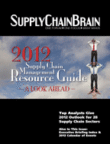
Visit Our Sponsors |
|
|
|
|
|
|
|
|
|
|
|
|
|
|
|
|
|
|
|
|
|
|
|
|
|
|
|
|
|
|
|
|
|
|
|
|
|
|
|
|
|
|
|
|
|
|
|
|
|
|
|
|
|
|
|
|
|
|
|
|
|
|
|
|
|
|
|
|

The complexion of next-generation rail fleet management is progressing to deal with the complex interaction of variable demand and variable transit times by digitally analyzing it in models that explicitly capture the capabilities and constraints of the rail network throughout the year.
Similarly, predictive analytic support for day-to-day operations is emerging as well as the ability to predict, with confidence, future operating conditions to maximize service and mitigate risk - all of which provides valuable insight for the sales and operations planning process.
Next-generation rail fleet management tools are beginning to answer key critical logistics questions such as:
• What do I have and what do I need? Lean fleet sizing needs to be complemented with lean operating policies and targets in order to guide execution, and with enhanced daily operating procedures that take advantage of new predictive control capabilities (e.g., alerts of pending railcar location discrepancies). Alerts provide advance warnings to operations - anywhere from 10 to 28 days - to take corrective action in order to avoid service failures.
• Where are my rail cars and where should they be in two to three weeks?
Next-generation rail fleet tools will improve management and operational control of rail transportation. It will provide rail management teams with important insight to participate and contribute in the S&OP process to improve overall business performance. Supply reliability is critical to business, and a rail management team needs to be able to respond quickly in a rapidly changing environment.
"What-if" scenario analyses will be highly valuable for conducting business contingency planning, especially for the critical hurricane season on the U.S. Gulf Coast. Estimates can be made concerning when rail cars will return (to the plants) and be available for loading. Reports and graphics can be provided to highlight times when there will be car shortages at the plants or exceed railcar storage limits at the various yards (operational alerts).
• Can I synchronize my rail fleet with manufacturing output? Companies pursuing operational excellence in their railcar operations need enhanced methodologies and tools to develop and sustain new high-performance operating procedures. Toward that end, three stages of maturity for achieving a high performance lean rail fleet are emerging: determining the lean size of the rail fleet; tuning operating policies and set points to guide execution; and enhancing daily operating procedures with the appropriate predictive control tools.
With the above in place, companies should be able to determine optimum fleet size, run "what-if" scenarios for demand/supply variability, weather and other disruption-related possibilities, and aid in business continuity planning.
The Outlook
In 2012 and beyond, look for predictive-analytics-based rail fleet management to provide rail fleet managers with innovative lean tools to improve fleet management. Lean operating processes, enhanced with predictive analytics, will provide new capabilities for improved performance. By applying predictive analytics with next-generation sales and operations planning techniques, rail service reliability will improve, and asset turnover and working capital will benefit, along with mitigating risk and therefore reducing cost.
Keywords: Rail & Intermodal, Transportation & Distribution, Logistics; Business Intelligence & Analytics, Sales & Operations Planning, Logistics; Quality & Metrics, Supply Chain Analysis & Consulting, Global Supply Chain Management, Predictive Analytics, Lean Fleets
RELATED CONTENT
RELATED VIDEOS
Timely, incisive articles delivered directly to your inbox.






